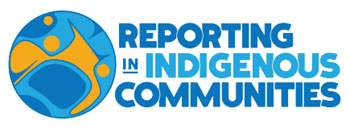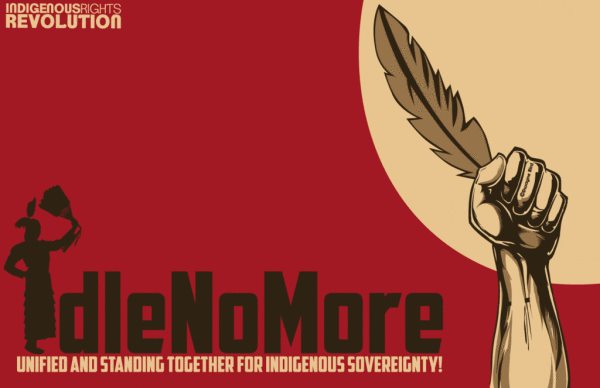13 Jul Media coverage of Idle No More raises questions about understanding First Nations
Thanks to Cara McKenna of the Langara Journalism Review for giving RIIC a nod – you can see the original article here.
Media coverage of Idle No More raises questions about understanding First Nations
Story by Cara McKenna
“I want to remind you as the media you are the leaders. How you write and how you demonstrate and how you forecast our relationship is important.” This was the message regional Chief Roger Augustine passed on to reporters at a meeting of chiefs of the Assembly of First Nations in Vancouver. He was referring to media coverage of the Idle No More movement, and went on to state:
“You determine the future and safety of our people by the way you write, and by the way you demonstrate your work. Your work has a lot of respect, a lot of dignity. I will always respect and acknowledge you, as well, but it has to work both ways.”
Determining how to portray an entire group of people creates a lot of pressure, especially when journalists aren’t completely sure what the Idle No More movement is really all about. While it may be easy to oversimplify the concept by tying it to single issues—the Enbridge Pipeline, treaty issues, the UN Declaration on the Rights of Indigenous Peoples, federal legislation affecting the environment (Bill C-45)—the lack of understanding, or attempts to understand, on the part of the media has drawn some criticism, even from journalists themselves.
“Idle No More from a journalist’s perspective has been, and still is, a challenging movement to cover because there isn’t a central issue per se,” says Duncan McCue, a reporter at CBC and the creator and curator of the online guide called Reporting in Indigenous Communities.
“It’s important to communicate with our audience in a short time frame that we have on radio and television, or the few number of words we have in print, to try to understand what the focus of the protests are about. But that said, I really appreciate the outlets that did, and have tried to offer context to those deeper issues. [Some] tried to go on, and said here’s an explainer on what the historic treaty relationship is; here’s an explainer on some of the First Nations’ concerns on Bill C-45. So that kind of thing, and to offer more context rather than just having a bunch of Indians marching down the road waving around placards and beating drums.”
McCue says several high-profile columnists—he names Jeffrey Simpson of the Globe and Mail as one—are expressing conservative views on aboriginal self-governance and sovereignty, causing anger among aboriginal communities, something that, according to McCue, demonstrates how many senior writers and commentators in Canada are still fairly “old school.”
“Many of what aboriginal people, and particularly people on the Idle No More movement, objected to were many of the opinion pieces—and I emphasize opinion pieces—by columnists in major news outlets that expressed more Conservative views on aboriginal self-governance and self-determination. And that’s understandable. That’s what columnists are there to do . . . to provoke thought and discussion and to do so sometimes in a controversial or a provocative manner. And unfortunately, a lot of those columnists became a flashpoint of anger, if you will.”
Perhaps even more of a concern are the immoderate comments posted by some people online in reaction to the coverage. While established media generally remove comments that are deemed racist or slanderous, some argue that comments critical of one or another identifiable group is not necessaily racist.
The Calgary Sun was accused of racism by more than 100 people who protested outside its newsroom last January for allowing what was seen as discriminatory comments on the paper’s website, and the posting of polls that were “stirring up the hate pot,” according to protesters.
Calgary Sun editor Jose Rodriguez responded with a column titled, “We are not racist,” defending the paper’s coverage of Idle No More.
“We are not racists. Period. Full stop. Our columnists may at times disagree with First Nations leaders such as Theresa Spence or Derek Nepinak. But disagreeing with or criticizing a person of a different race does not make someone a racist. Treating native issues by a different set of rules, now that would be racist,” Rodriguez wrote.
He went on: “We’re not afraid of being called names when we shine a light on injustice, misspending or anything else that affects the lives of our readers, viewers and users. We make no apologies for that. There are issues around accountability with regards to the billions of dollars that taxpayers give to First Nations. There are countless businesses that are being disrupted by protests led by a group that, at times, seems unclear as to what it really wants.”
Idle No More wants to blame government for some of the very real problems that plague reserves, but seem unwilling to look inward. At their own leadership. At where the billions of dollars have ended up. They seem reluctant to ask for accountability from their own. And now there are threats that they will bring our economy to its knees with blockades and other actions.”
Referring to the controversial comments left by readers on Web stories, Rodriguez wrote:
“We believe in freedom of speech. In providing a forum for unfettered commentary. We expect our readers to engage in lively real-time debates. We also expect them to police themselves, flagging any inappropriate comments for us to remove—something we do so more often than we’d like to admit.”
 One Manitoba newspaper, the Thompson Citizen, even went so far to delete its entire Facebook page, writing: “We won’t mince words here. We’re leaving because for some time commenters have been posting virulently racist, anti-aboriginal comments on our page and tagging photos in a similar way, including our profile photo of the Thompson Citizen building this morning. It ends here. This newspaper is not going to stand by and let anti-aboriginal racists and haters spew their evil on a vehicle we’re facilitating them using.”
One Manitoba newspaper, the Thompson Citizen, even went so far to delete its entire Facebook page, writing: “We won’t mince words here. We’re leaving because for some time commenters have been posting virulently racist, anti-aboriginal comments on our page and tagging photos in a similar way, including our profile photo of the Thompson Citizen building this morning. It ends here. This newspaper is not going to stand by and let anti-aboriginal racists and haters spew their evil on a vehicle we’re facilitating them using.”
Most recently, the Nanaimo Daily News was under fire for publishing a letter from a reader that drew immediate criticism from members of the aboriginal community and others.
The letter, written by Don Olsen, stated First Nations “have a history that is notable only for underachievement” and “are just in the last 200 years getting caught-up to most of the rest of the world.” It also called First Nations too irresponsible to look after themselves and suggested “traditional use” and “cultural nonsense” be done away with.
Dozens of protesters showed up at the News office, accusing the newspaper of repeatedly printing racist letters. Assembly of First Nations Chief Shawn Atleo said the letter reflected a “deep disconnect, misunderstanding and ignorance about First Nations people from coast to coast to coast.”
Times publisher Hugh Nicholson apologized, but also defended Olsen’s “right to hold and express his opinion,” adding that “the sentiments expressed were entirely his own and in no way reflect the views of the newspaper.”
Journalist Michael Harris, writing on the website iPolitics, says newspapers should be more responsible. In a story called “First Nations: The media misses the point—again,” Harris criticizes the media for reporting what is easy—the tabloid-friendly angle aligned with what they want to believe—and that journalists are simply lazy when it comes to reporting aboriginal issues.
“Here is what a lot of people want to believe about the Aboriginal Spring in Canada. They hold fast to the idea that the only thing behind native unrest is a bottomless lust for public subsidies. They want to believe that Canada has been just and generous to this misfit people who stubbornly won’t assimilate. They cling to the notion that, left to their own devices, aboriginals are unable to govern themselves and will quickly fall into corruption,” Harris wrote.
McCue says the solution to this lack of awareness on the part of the media isn’t simple or quick, but progress could be made if reporters made more of an effort to understand complex issues, and, of course, by not getting sloppy with facts.
While people with placards marching in the streets are typical events for the media to cover, he stresses that reporters need to understand the deep-seated issues behind the movement; that Idle No More is not a simple matter of people marching in the streets. This may be something that can be challenging for a reporter who doesn’t already have the knowledge base. Having more aboriginal reporters would be helpful, as well, McCue believes.
When Idle No More began, McCue organized a meeting for reporters and producers at CBC in Vancouver to discuss some of the issues being raised, and strategies on how best to cover it.
“That’s unusual,” says McCue. “It’s not something that happens typically. I thought it was a good idea so I kind of was a resource . . . but it was a much more broad conversation than me just lecturing at people about things to do. It was a broad, newsroom-based conversation about ‘How do we cover this?’ and ‘What are some of the ethics involved?’”
He says the session was helpful but it can’t be just a one-off. “There’s always room for improvement when it comes to coverage of aboriginal issues in the mainstream media.”







